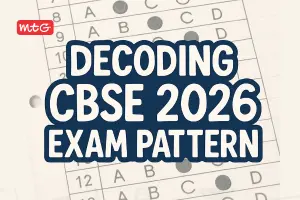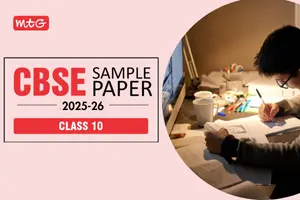Access MCQ questions and answers for CBSE Class 10 Science Chapter 10 on The Human Eye and The Colourful World here. These questions are designed according to the Class 10 Science syllabus, prescribed by CBSE and NCERT for Class 10. MCQs are an important part of class 10 Science exams; practising them can help improve your scores. Explore more chapter-wise MCQ questions on The Human Eye and The Colourful World with answers to assess your knowledge level.
CBSE Class 10 Chapter 10 The Human Eye and the Colourful World MCQs
Check below the CBSE Class 10 Science MCQ with answers and Clear your idea of Light-Reflection and Refraction.
Q.1. A parallel beam of light falling on the eye gets focused on the retina because of refractions at
(a) the cornea
(b) the crystalline lens
(c) the vitreous humor
(d) various surfaces in the eye.
Answer
Practice More – CBSE Practice Papers Class 10 – Free PDF Download
Q.2. Variable focal length of eye lens is responsible for
(a) accommodation of eye
(b) persistence of vision
(c) colour blindness
(d) least distance of distinct vision.
Answer
Q.3. Which of the following coloured light among seven colours on passing white light through a glass prism is bottom most?
(a) violet (b) yellow
(c) red (d) green
Answer
(a): The violet colour has the minimum speed in the glass prism, so the violet colour is deviated the maximum. Due to this, violet colour appears at the bottom of the spectrum
Also Check – CBSE Sample Papers Class 10 for Board Exams
Q.4. A beam of white light when passes through a glass prism, a spectrum is observed. But when same beam of light passes through hollow glass prism then
(a) spectrum is same
(b) spectrum become brighter
(c) there will be no spectrum
(d) colours of spectrum reversed
Answer
Q.5. Sunset is red because at that time the light coming from the sun has to travel
(a) lesser thickness of earth’s atmosphere
(b) greater thickness of earth’s atmosphere
(c) varying thickness of earth’s atmosphere
(d) along the horizon.
Answer
Q.6. The intensity of scattered light varies inversely as nth power of wavelength (λ) of incident light where
(a) n = 2 (b) n = 1
(c) n = 4 (d) n = – 4
Answer
Q.7. Which of the following is not caused by the atmospheric refraction of light?
(a) twinkling of stars at night
(b) sun appearing higher in the sky than it actually is
(c) sun becoming visible two minutes before actual sunrise
(d) sun appearing red at sunset
Answer
Q.8. A ray of light passes through a prism as shown in the figure.

The angle δ is known as
(a) angle of deviation
(b) angle of dispersion
(c) angle of emergence
(d) angle of refraction
Answer
CBSE Class 10 Resources – Important Formula Book For 10th Science
Q.9. Sheela cannot read newspaper when she holds it closer than 100 cm. The defect in her eye and the power of lens prescribed to her is (Normal eye near point = 25 cm)
(a) myopia with + 3 D lens
(b) myopia with – 3 D lens
(c) hypermetropia with – 3 D lens
(d) hypermetropia with + 3 D lensSelect the incorrect statement stated below related to concave mirror.
Answer

Q.10. When white light is passed through an upside-down (inverted) prism then
(a) white light is obtained
(b) spectrum is obtained with violet colour undergoing maximum deviation and red colour undergoing minimum deviation
(c) spectrum is obtained with red colour undergoing maximum deviation and violet colour undergoing minimum deviation
(d) light gets blocked
Answer

CBSE Class 10 Science The Human Eye and the Colourful World MCQs – PDF Download
Answers-
Summary for NCERT class 10 science chapter 10 – “The Human Eye and the Colourful World”
- The ability of the eye to focus on both near and distant objects, by adjusting its focal length, is called the accommodation of the eye.
- The smallest distance, at which the eye can see objects clearly without strain, is called the near point of the eye or the least distance of distinct vision. For a young adult with normal vision, it is about 25 cm.
- The common refractive defects of vision include myopia, hypermetropia and presbyopia. Myopia (short-sightedness – the image of distant objects is focussed before the retina) is corrected by using a concave lens of suitable power. Hypermetropia (far-sightedness – the image of nearby objects is focussed beyond the retina) is corrected by using a convex lens of suitable power. The eye loses its power of accommodation at old age.
- The splitting of white light into its component colours is called dispersion.
- Scattering of light causes the blue colour of sky.
Best Reference Books for Class 10 Science
- NCERT Textbook + Exemplar Problems-Solutions
- Foundation Course Physics, Chemistry and Biology
- NCERT at your Fingertips Science
- 100 Percent Science
- CBSE 10 Years Chapterwise Topicwise Solved Papers AKA CBSE Champion
- CBSE Chapterwise Question Bank
- CBSE Score More 15 Sample Question Papers
We hope the MCQs for the CBSE Class 10 Science Chapter 10 on The Human Eye and the Colourful World are helpful for your board exam preparation.
Keep learning and stay updated with us for more CBSE exam updates.






























